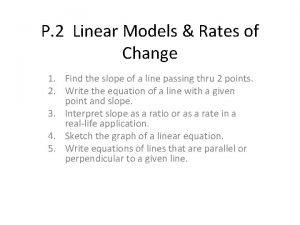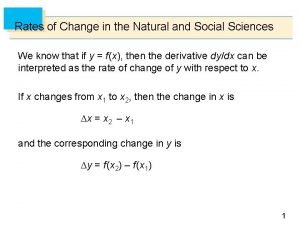3 4 RATES OF CHANGE RATES OF CHANGE
















- Slides: 16

3. 4 RATES OF CHANGE

RATES OF CHANGE � Example 1: � Find rate ofinchange If r is the measured inches of Area of a circle andthe A is measured in square inches, towhat units would be appropriate for with respect its radius. d. A/dr? in 2/in These are units, so we do not cancel them!!! � Evaluate 10. the rate of change of A at r = 5 and r =

MOTION � Displacement of an object is how far an object has moved over time. � Average velocity is the slope of a displacement vs. time graph.

MOTION � Instantaneous certain point. Velocity is the velocity at a � Instantaneous Velocity is the first derivative of the position function. � Speed is the absolute value of velocity.

MOTION � Acceleration is the rate at which a particle’s velocity changes. � Measures how quickly the body picks up or loses speed. � 2 nd derivative of the position function!!!

EXAMPLE � A particle moves along a line so that its position at any time t ≥ 0 is given by the function s(t) = 2 t 2 – 5 t + 3 where s is measured in meters and t is measured in seconds. a. ) Find the displacement of the particle during the first 2 seconds. b. ) Find the average velocity of the particle during the first 6 seconds.

EXAMPLE � A particle moves along a line so that its position at any time t ≥ 0 is given by the function s(t) = 2 t 2 – 5 t + 3 where s is measured in meters and t is measured in seconds. c. ) Find the instantaneous velocity of the particle at 6 seconds. d. ) Find the acceleration of the particle when t = 6.

EXAMPLE � A particle moves along a line so that its position at any time t ≥ 0 is given by the function s(t) = 2 t 2 – 5 t + 3 where s is measured in meters and t is measured in seconds. e. ) When does the particle change directions?

It is important to understand the relationship between a position graph, velocity and acceleration: acc neg vel pos & decreasing acc neg vel neg & decreasing acc zero vel pos & constant distance velocity zero acc pos vel pos & increasing acc zero vel neg & constant acc pos vel neg & increasing acc zero, velocity zero time

FREE-FALL Gravitational Constants: Free-fall equation: s is the position at any time t during the fall g is the acceleration due to Earth’s gravity (gravitational constant)

VERTICAL MOTION � Example: A dynamite blast propels a heavy rock straight up with a launch velocity of 160 ft/sec. It reaches a height of s = 160 t – 16 t 2 ft after t seconds. a. ) How high does the rock go? Find when position = 0 and divide by 2 (symmetric path) Since it takes 10 seconds for the rock to hit the ground, it takes it 5 seconds to reach it max height.

VERTICAL MOTION � Example: A dynamite blast propels a heavy rock straight up with a launch velocity of 160 ft/sec. It reaches a height of s = 160 t – 16 t 2 ft after t seconds. a. ) How high does the rock go? Find when velocity = 0 (this is when the rock changes direction)

VERTICAL MOTION Example: A dynamite blast propels a heavy rock straight up with a launch velocity of 160 ft/sec. It reaches a height of s = 160 t – 16 t 2 ft after t seconds. b. ) What is the velocity and speed of the rock when it is 256 ft above the ground on the way up? � At what time is the rock 256 ft above the ground on the way up?

VERTICAL MOTION Example: A dynamite blast propels a heavy rock straight up with a launch velocity of 160 ft/sec. It reaches a height of s = 160 t – 16 t 2 ft after t seconds. b. ) What is the velocity and speed of the rock when it is 256 ft above the ground on the way down? � At what time is the rock 256 ft above the ground on the way down?

VERTICAL MOTION Example: A dynamite blast propels a heavy rock straight up with a launch velocity of 160 ft/sec. It reaches a height of s = 160 t – 16 t 2 ft after t seconds. c. ) What is the acceleration of the rock at any time t during its flight? �

from Economics: Marginal cost is the first derivative of the cost function, and represents an approximation of the cost of producing one more unit. Marginal revenue is the first derivative of the revenue function, and represents an approximation of the revenue of selling one more unit.
 Ratios guided notes
Ratios guided notes Ratios rates and unit rates
Ratios rates and unit rates Ratios rates and unit rates
Ratios rates and unit rates Unit rate
Unit rate 1-4 practice extrema and average rates of change
1-4 practice extrema and average rates of change Linear models and rates of change
Linear models and rates of change Rate of change and slope
Rate of change and slope Rates of change in the natural and social sciences
Rates of change in the natural and social sciences Examples of physical changes
Examples of physical changes Whats the difference between a chemical and physical change
Whats the difference between a chemical and physical change Difference between physical and chemical change
Difference between physical and chemical change Chopping wood a physical or chemical change
Chopping wood a physical or chemical change Which is an example of a physical change
Which is an example of a physical change What is a chemical change
What is a chemical change When does a physical change occur study jams
When does a physical change occur study jams Input and output markets
Input and output markets Climate change 2014 mitigation of climate change
Climate change 2014 mitigation of climate change































